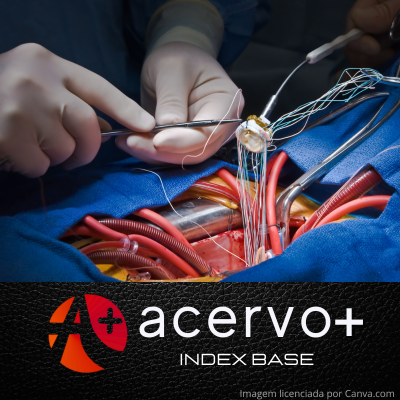A eficiência de novas tecnologias na terapêuticas calcificação valvar
##plugins.themes.bootstrap3.article.main##
Resumo
Objetivo: Investigar como os avanços na compreensão dos mecanismos moleculares da calcificação valvar podem impactar o desenvolvimento e a eficácia das novas terapias emergentes para o tratamento dessa condição, comparando com os métodos tradicionais. Métodos: Esta revisão integrativa da literatura. PubMed e Biblioteca Virtual em Saúde (BVS), focando em artigos publicados nos últimos cinco anos, entre 2019 e 2024. O objetivo da revisão foi identificar estudos que abordassem os mecanismos moleculares da Calcificação da Válvula Aórtica (CAVD) e potenciais intervenções terapêuticas. A busca foi realizada utilizando descritores Decs/MeSH relevantes, incluindo "calcification," "RNA," "valve calcification," e "aortic valve calcification." Inicialmente, 422 estudos foram identificados antes da triagem. Resultados: A análise revelou avanços significativos com biomarcadores, como o cfDNA, IL-38 e microRNAs, e terapias experimentais com vitamina K2, curcumina e H₂S, que mostraram potencial em inibir a progressão da calcificação valvar. Considerações finais: As novas terapias moleculares apresentam resultados promissores para o tratamento da calcificação valvar. Contudo, estudos futuros devem incluir amostras maiores e mais diversificadas para validar sua eficácia em diferentes populações e, assim, ampliar a aplicabilidade clínica dessas tecnologias.
##plugins.themes.bootstrap3.article.details##
Copyright © | Todos os direitos reservados.
A revista detém os direitos autorais exclusivos de publicação deste artigo nos termos da lei 9610/98.
Reprodução parcial
É livre o uso de partes do texto, figuras e questionário do artigo, sendo obrigatória a citação dos autores e revista.
Reprodução total
É expressamente proibida, devendo ser autorizada pela revista.
Referências
2. FU, Z. et al. Histone deacetylase 6 reduction promotes aortic valve calcification via an endoplasmic reticulum stress-mediated osteogenic pathway. Journal of thoracic and cardiovascular surgery/The Journal of thoracic and cardiovascular surgery/The journal of thoracic and cardiovascular surgery, 2019; 158(2): 408-417.
3. HUANG, Q. et al. Berberine inhibits osteogenic differentiation of aortic valve interstitial cells induced by osteogenic induction medium. Zhongguo Zhong Yao Za Zhi, 2022; 47(11): 3059–3065.
4. JIAO, W. et al. MicroRNA‐638 inhibits human aortic valve interstitial cell calcification by targeting Sp7. Journal of Cellular and Molecular Medicine, 2019; 23(8): 5292–5302.
5. KOWALSKI, L. et al. Vitamin K2 and D in patients with aortic valve calcification: a randomized double-blinded clinical trial. Circulation, [s.l.], 2022; 121(6): 1234-1241. DOI: 10.1161/CIRCULATIONAHA.121.057008.
6. LIU, X. et al. Schisandrol B inhibits calcification of aortic valve by targeting p53 related inflammatory and senescence. Biomedicine & Pharmacotherapy, 2024; 178: 117241. DOI: 10.1016/j.biopha.2024.117241.
7. LU, P. et al. MicroRNA-138 Suppresses Osteoblastic Differentiation of Valvular Interstitial Cells in Degenerative Calcific Aortic Valve Disease. International Heart Journal, 2019; 60(1): 136–144.
8. MA, W. et al. Plasma Cell-Free DNA Is a Potential Biomarker for Diagnosis of Calcific Aortic Valve Disease. Cardiology, 2024; 149(2): 155–162.
9. MENDES, et al. Revisão integrativa: método de pesquisa para a incorporação de evidências na saúde e na enfermagem. Texto & Contexto - Enfermagem, 2008; 17(4): 758–764.
10. RAGGI, P. et al. Slowing Progression of Cardiovascular Calcification with SNF472 in Patients on Hemodialysis: Results of a Randomized, Phase 2b Study. Circulation, p. 10.1161/CIRCULATIONAHA.119.044195, 2019.
11. RIGGIO, M. et al. Effect of denosumab or alendronate on vascular calcification: secondary analysis of SALTIRE2 randomized controlled trial. Journal of the American Heart Association, [s.l.], 2023; 12(7): e032571. DOI: 10.1161/JAHA.123.032571.
12. SALIM, M. T. et al. miR-214 is Stretch-Sensitive in Aortic Valve and Inhibits Aortic Valve Calcification. Annals of biomedical engineering, 2019; 47(4): 1106–1115.
13. SAKAUE, T. et al. Valve Interstitial Cell-Specific Cyclooxygenase-1 Associated With Calcification of Aortic Valves. The Annals of Thoracic Surgery, 2019; 110(1): 40–49.
14. SONG, J.-K. et al. Effect of Evogliptin on the Progression of Aortic Valvular Calcification. Journal of the American College of Cardiology, v. 84, n. 12, p. 1064–1075, 2024.
15. SONG, N. et al. Hydrogen sulfide inhibits gene expression associated with aortic valve degeneration by inducing NRF2-related pro-autophagy effect in human aortic valve interstitial cells. Molecular and Cellular Biochemistry, 2023; 479(10): 2653–2662.
16. TAKU TOSHIMA et al. Therapeutic inhibition of microRNA-34a ameliorates aortic valve calcification via modulation of Notch1-Runx2 signalling. Cardiovascular Research, 2019.
17. THE, E. et al. Interleukin 38 alleviates aortic valve calcification by inhibition of NLRP3. 2022; 119(36): 29.
18. VANHOOF, V. et al. Atorvastatin effect on aortic dilatation and valvular calcification progression in bicuspid aortic valve (BICATOR): a randomized clinical trial. Circulation, [s.l.], 2023; 123(4): 345-353. DOI: 10.1161/CIRCULATIONAHA.123.067537.
19. WANG, S. et al. Nesfatin-1 mitigates calcific aortic valve disease via suppressing ferroptosis mediated by GSH/GPX4 and ZIP8/SOD2 axes. Free Radical Biology and Medicine, 2024; 222: 149–164.
20. ZENG, P. et al. ERK1/2 inhibition reduces vascular calcification by activating miR-126-3p-DKK1/LRP6 pathway. Theranostics, 2021; 11(3): 1129–1146.
21. ZHOU, T. et al. Curcumin inhibits calcification of human aortic valve interstitial cells by interfering NF‐κB, AKT, and ERK pathways. Phytotherapy Research, 2020; 34(8): 2074–2081.

